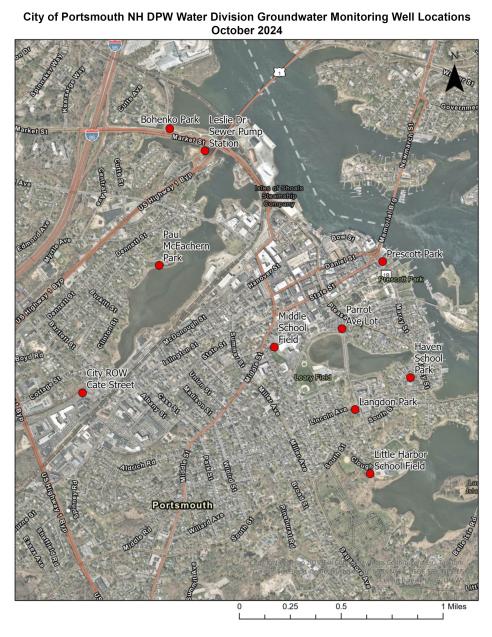City Expands DPW Groundwater Monitoring Project
October 2, 2024
The City of Portsmouth Department of Public Works is partnering with HydroPredictions, the New Hampshire Department of Environmental Services, the University of New Hampshire, and Jennifer M. Jacobs and Associates, LLC, on a groundwater monitoring project. The project will assess baseline groundwater levels, water, sewer, and stormwater infrastructure, and the vulnerabilities the built environment faces from rising water table levels in Portsmouth stemming from sea level rise.
The City plans to install small groundwater monitoring wells on City property in highly vulnerable locations. The locations were chosen based on groundwater rise simulations, mapping studies using LiDAR, ground-surface elevations, the accessibility of the site for well placement, and the avoidance of utility infrastructure. Locations include the corners of the Middle School and Little Harbour Elementary School athletic fields, Bohenko Gateway Park, Prescott Park, Haven School Park, Langdon Park, Paul McEachern Park, the Parrott Avenue Lot, and two City right-of-way locations on Cate Street and Leslie Drive.
The project consists of the drilling of ten small, shallow wells, about 20 feet deep, with four-inch steel protective casings and concrete anchor pads on downtown City property at varying distances from the coast to monitor both tidal impacts and to assess groundwater changes further inland. The drilling work is anticipated to take place over several days, starting on October 8 and concluding with the school properties on the Monday holiday, October 14, 2024 to minimize disruption.
By identifying vulnerable areas for rising groundwater and surface-water flooding, Portsmouth can protect existing City infrastructure and include adaptation planning in future maintenance, design, and construction projects. The City has already partnered with the University of New Hampshire and Strawbery Banke Museum for real-time monitoring of groundwater fluctuations at several sites in the South End.
All funding for the project was provided by the New Hampshire Department of Environmental Services Drinking Water and Groundwater Bureau and the NH Coastal Program. Support for the project is part of the broader effort to inform and assist coastal cities and towns in reducing their susceptibility to utility and infrastructure impacts from both natural hazards and climate-driven increases in seawater and groundwater l

